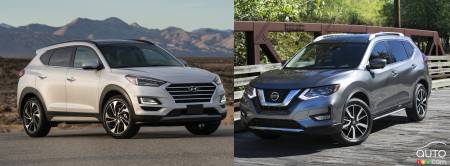The Hyundai Tucson comes from a modest background, but over the generations it’s become a serious short-list contender in the compact SUV category. Over time it has traded in its entry-level status (now handed off to the new Kona and eventually the future Venue); concurrently its rather simple (ok, simplistic) initial styling has evolved and is now more refined.
As for the Nissan Rogue, it’s currently the brand's best-selling vehicle in Canada. Like the Tucson, its humble beginnings as an entry-level model are also a thing of the past, the Rogue having given its title away to smaller models the Qashqai and the newish Kicks.
See also: The Top 10 Compact SUVs in Canada in 2018
Hyundai Tucson
There are quite a few new features for the Tucson in 2019. The most substantial is the decision to get rid of the 1.6L turbo engine option in favour of a 2.4L unit borrowed from the Santa Fe and Sonata – a decision motivated by the many mechanical troubles of the turbo engine and dual-clutch transmission.
Specifications for the 2019 Hyundai Tucson

Visually, well, you could line up a dozen SUVs in this category side by side and struggle to identify them with certainty. For 2019, the Tucson does get some slight changes inspired by the recent Kona touching on the design of the grille and front headlights. The rear lights’ design is also new and you get subtle alterations to the rear quarter panel.
More standard technology
While it’s found itself a little behind in term of technology in recent years, Hyundai makes up ground this year by including pre-collision assist, lane control and a drowsiness monitoring system by default in all trims of the Tucson (except the basic version). All versions are offered with Apple CarPlay and Android Auto as standard equipment.
The base engine remains the same with a 4-cylinder 2.0L naturally aspirated engine producing 161 hp and 150 lb-ft of torque managed using a 6-speed automatic transmission and front-wheel drive, with all-wheel drive available as an option. The 2.4L engine has 181 hp and 175 lb-ft (up from 175 hp and down from 195 lb-ft with the old 1.6L turbo). This unit also comes with a 6-speed automatic and 4WD series.
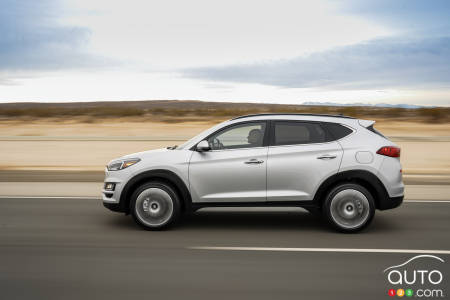
Four trim levels
The Tucson comes in four different trims: Essential, Preferred, Luxury and Ultimate.
The Essential version comes with 17-inch steel wheels, LED daytime running lights, fog lights, heated mirrors, a wiper defroster, fabric seats, a six-way manual driver's seat, heated front seats, a 7.0 inch multimedia touch screen, air conditioning, cruise control, trip computer, power windows and electric locks with keyless entry.
The Preferred version adds alloy wheels, blind spot monitoring, heated rear seats, leather-wrapped steering wheel and shifter, lane departure warning with lane assist and pre collision warning.
Leather seats are included in the Luxury version which also adds an eight-way electric driver seat with lumbar support, a satellite radio, a dual-zone automatic climate control, a panoramic roof, an auto-dimming rear view mirror, garage door opener, passive keyless entry with push button start. a synthetic leather dashboard trim and an electric parking brake.
The Ultimate version includes 19-inch wheels, LED headlights and taillights, chrome-trimmed exterior trim, rain-sensing wipers, power-adjustable passenger seat, ventilated front seats, multimedia information display 8.0-inch navigation, a rear parking assist, a 4.2-inch LCD display on the instrument cluster, adaptive cruise control, pedestrian detection, driver alert and automatic high beam.
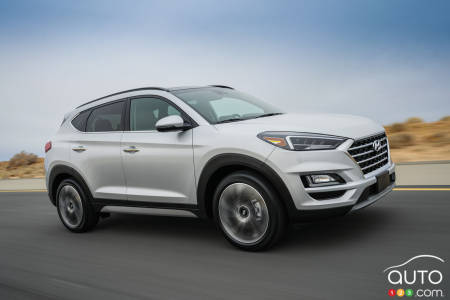
Uneventful driving
Whatever the version, the Tucson provides predictable driving; there’s little chance of it awaking your senses very much at all. With struts at the front and a multi-link rear suspension, the Tucson is a bit firm with the 19-inch tires, but comfort levels rise appreciably when the SUV is shod with the 17-inch tires. The all-wheel drive system works effectively, and you have a drive-mode selector that allows the driver to add weight to the steering and speed up downshifts, but the overall driving sensation stays the same.
Nissan Rogue
Nissan has a lot riding on the Rogue and made it its best seller through promotion and rebate in recent years. Its practical format and realistic price have made it a very popular model. It is also one of the few small SUV in this class to offer a third row of seats.
Small changes for 2019 include increased availability of electronic driver assistance such as lane departure warning, pedestrian detection with emergency braking and automatic high beam. The ProPilot Driver Assistance System becomes an option in the SV version and standard on the SL, where it was previously optional.
Specifications for the 2019 Nissan Rogue
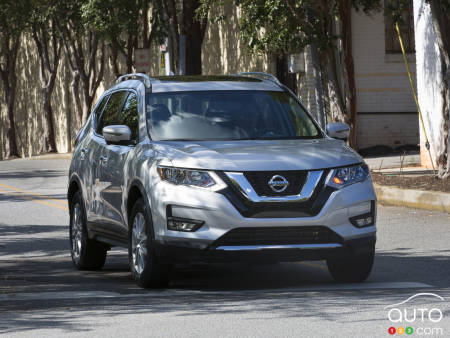
Still the same engine
Under the hood, we still find the 2.4L 4-cylinder developing 170 hp and 175 lb-ft of torque, coupled with a continuously variable automatic transmission (CVT).
The S and SV versions start with front-wheel drive but can be equipped with an AWD; that comes standard on the SL model. The basic S version also comes with 17-inch steel wheels, LED daytime running lights and rear lights, heated exterior mirrors, air conditioning, electric windows and locks, tilt and telescopic steering column, cruise control, 7.0-inch touchscreen, front collision warning with automatic braking and blind spot monitoring with rear cross traffic alert.
The alloy wheels arrive on the SV model with fog lamps, a keyless entry, a remote starter, a six-speaker stereo system, a lane departure warning, intelligent cruise control and automatic high beam.
The SL switches to 19-inch wheels, a hands-free trunk, a sunroof, navigation, 360-degree outdoor camera views, automatic climate control, power-adjustable front seat, leather upholstery, premium 9-speaker audio system, rear-wheel-drive automatic with moving object detection, rear parking sonar and ProPilot Assist system.
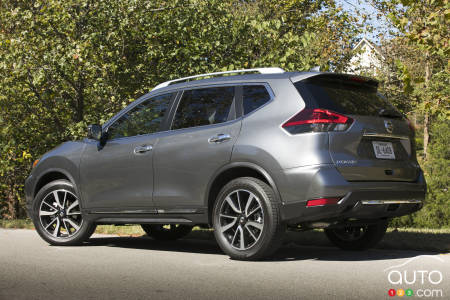
Economy before pleasure
Keep in mind that Nissan prioritizes fuel economy ahead of driving pleasure. You will not get much from the 4-cylinder engine and you will be raging occasionally with the CVT box that shouts his discontent with every firm acceleration. It's true that the Rogue gets slightly better fuel economy than the Tucson. But frankly, we’re ready to sacrifice these few drops of fuel for the added pleasure of driving a Tucson.
Tucson advantages
The Tucson offers better rear seat space, a marginally more efficient all-wheel drive system, and better towing capacity if you haul a heavier load. You also have a warranty that will keep your peace of mind longer at Hyundai.
Rogue advantages
As we pointed out earlier, your gas mileage will be a little better with the Rogue as cargo space. We must also give a slight increase in comfort for the zero gravity seats in the Rogue.

Similarities
Fuel consumption will not be a decisive factor in choosing one or the other of these two models. The purchase price is also very close, and as mentioned neither of the two models will make your hair rise up when in full acceleration.
Verdict
In the end, if we had to choose one to buy, our nod would go to a Tucson with 2.4L engine. The model is more spacious and the atmosphere on board more interesting and especially there is no CVT box. We also find the all-wheel drive more efficient in the Tucson.
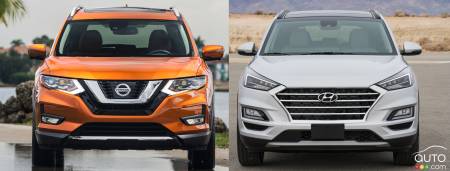
Hyundai Tucson
We liked
On board quietness
Overall looks
Proactive all-wheel-drive system
Better warranty coverage
We liked less
Smaller cargo space
2.0L engine not very compelling
Some unsightly plastics (on the base models)
Nissan Rogue
We liked
A lot of safety equipment
Comfortable zero-gravity seats
Generous cargo space
We liked less
CVT box
Stripped-down base model
Boring driving experience
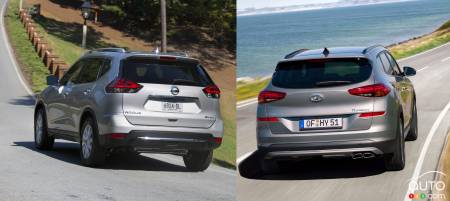
Specifications
| ... | 2019 Hyundai Tucson | 2019 Nissan Rogue | |
| Transmission | 6-speed auto | CVT | |
| Drivetrain | 2WD & 4WD | 2WD & 4WD | |
| 2.0L AWD | AWD | ||
| Fuel consumption (city) | 10.0L/100 km | 9.2L/100 km | |
| Fuel consumption (highway) | 7.9L/100 km | 7.0L/100 km | |
| 2.4L AWD | |||
| Fuel consumption (city) | 10.8L/100 km | ||
| Fuel consumption (highway) | 9.2L/100 km | ||
| Fuel tank | 62 litres | 55 litres | |
| Engine | 2.0L | ||
| Type | Gas | Gas | |
| Output | 164 hp | 170 hp | |
| Torque | 141 lb-ft | 175 lb-ft | |
| Cylinders | 4 cylinders | 4 cylinders | |
| Displacement | 2.0L | 2.0L | |
| 2.4L | |||
| Output | 181 hp | ||
| Torque | 175 lb-ft | ||
| Cylinders | 4 cylinders | ||
| Displacement | 2.4L | ||
| Capacities | |||
| Cargo space | 877 l, 1,754 l | 906 l, 1,982 l | |
| Towing capacity | 680 kg | 454 kg | |
| Dimensions | |||
| Length | 4,475 mm | 4,630 mm | |
| Width | 1,850 mm | 1,840 mm | |
| Height | 1,650 mm | 1,684 mm | |
| Wheelbase | 2,770 mm | 2,706 mm | |
| Warranty | 5 yrs/ 100,000 km | 3 yrs/ 60,000 km | |
| Pricing | $25,559 to $37,999 | $26,798 to $37,398 |


